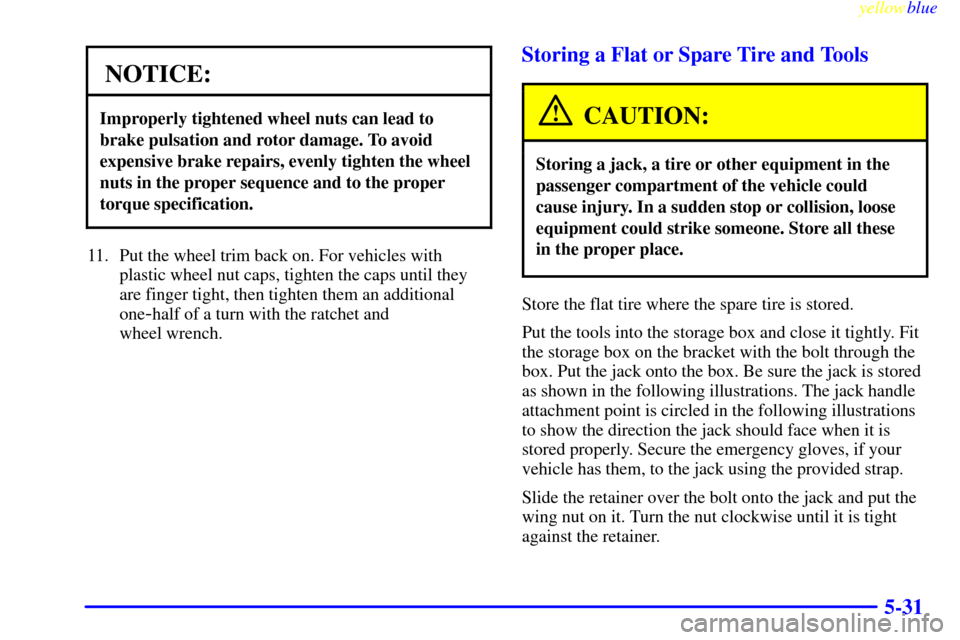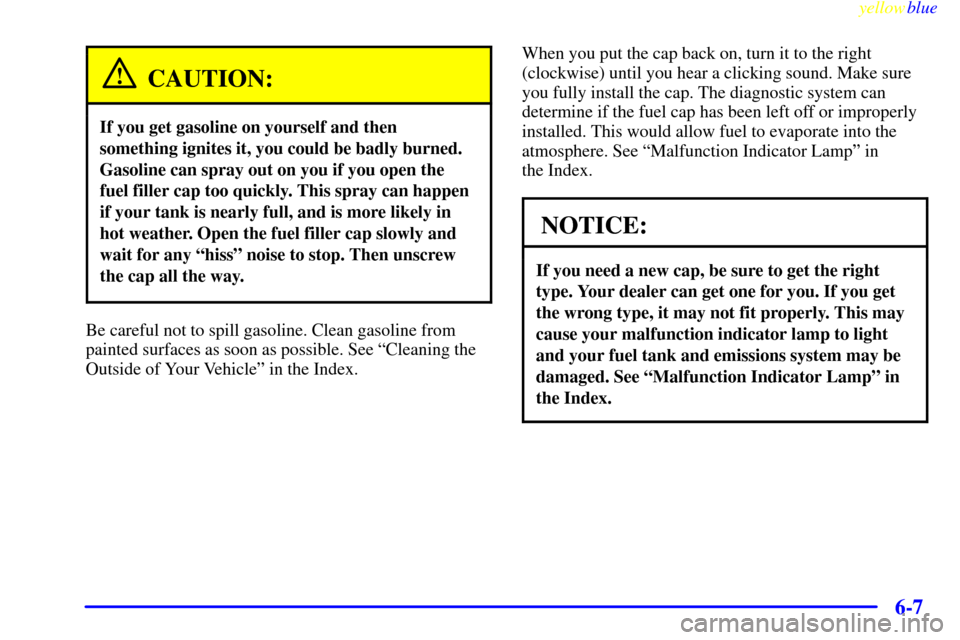Page 268 of 424
yellowblue
5-26 Removing the Flat Tire and Installing the
Spare Tire
1. Use the ratchet and
wheel wrench to loosen
all the wheel nuts. Turn
the wheel wrench
counterclockwise, with
DOWN facing you, to
loosen the wheel nuts.
Don't remove the wheel
nuts yet.
2. If the flat tire is on the rear of the vehicle, put the
jack handle extension on the jack handle.
3. Position the jack under the vehicle. If the flat tire is
on the front of the vehicle, position the jack on the
frame behind the flat tire. If the flat tire is on the rear
of the vehicle, position the jack on the axle near the
flat tire between the spring and the shock absorber.
Page 269 of 424
yellowblue
5-27
CAUTION:
Getting under a vehicle when it is jacked up is
dangerous. If the vehicle slips off the jack, you
could be badly injured or killed. Never get under
a vehicle when it is supported only by a jack.
CAUTION:
Raising your vehicle with the jack improperly
positioned can damage the vehicle and even make
the vehicle fall. To help avoid personal injury and
vehicle damage, be sure to fit the jack lift head
into the proper location before raising the
vehicle.
Front Position Rear Position
4. With UP on the ratchet facing you, raise the vehicle
by rotating the ratchet and wheel wrench clockwise.
Raise the vehicle far enough off the ground so there
is enough room for the spare tire to fit.
Page 271 of 424
yellowblue
5-29
7. Replace the wheel
nuts with the
rounded end of the
nuts toward the
wheel. Tighten
each wheel nut by
hand using the
wheel wrench until
the wheel is held
against the hub.
Front Position Rear Position8. Lower the vehicle by rotating the ratchet and
wheel wrench counterclockwise. Lower the
jack completely.
9. Tighten each
wheel nut by
rotating the wheel
wrench clockwise.
Page 272 of 424
yellowblue
5-30
10. Tighten the nuts firmly in a crisscross sequence as
shown. Rotate the wheel wrench clockwise.
CAUTION:
Incorrect wheel nuts or improperly tightened
wheel nuts can cause the wheel to become loose
and even come off. This could lead to an accident.
Be sure to use the correct wheel nuts. If you have
to replace them, be sure to get new GM original
equipment wheel nuts.
Stop somewhere as soon as you can and have the
nuts tightened with a torque wrench to the
proper torque. For proper torque, see
ªCapacities and Specificationsº in the Index.
Page 273 of 424

yellowblue
5-31
NOTICE:
Improperly tightened wheel nuts can lead to
brake pulsation and rotor damage. To avoid
expensive brake repairs, evenly tighten the wheel
nuts in the proper sequence and to the proper
torque specification.
11. Put the wheel trim back on. For vehicles with
plastic wheel nut caps, tighten the caps until they
are finger tight, then tighten them an additional
one
-half of a turn with the ratchet and
wheel wrench.
Storing a Flat or Spare Tire and Tools
CAUTION:
Storing a jack, a tire or other equipment in the
passenger compartment of the vehicle could
cause injury. In a sudden stop or collision, loose
equipment could strike someone. Store all these
in the proper place.
Store the flat tire where the spare tire is stored.
Put the tools into the storage box and close it tightly. Fit
the storage box on the bracket with the bolt through the
box. Put the jack onto the box. Be sure the jack is stored
as shown in the following illustrations. The jack handle
attachment point is circled in the following illustrations
to show the direction the jack should face when it is
stored properly. Secure the emergency gloves, if your
vehicle has them, to the jack using the provided strap.
Slide the retainer over the bolt onto the jack and put the
wing nut on it. Turn the nut clockwise until it is tight
against the retainer.
Page 276 of 424
yellowblue
5-34
Store the flat tire in the cargo area of two-door utility
and Suburban models and secure it to the tire carrier. To
store the flat tire:
1. Put the cover back on the tire if your vehicle has one.
2. Put the flat tire in the cargo area of the vehicle, over
the retainer bolt.
3. Slide the adapter onto the bolt in the proper location
for your model and put the wing nut on.
4. Turn the wing nut clockwise until the adapter is tight
and secure against the wheel.
5. Close the tire cover, if you have one.
Spare Tire -- 2-Door Utility Model
1. Carrier
2. J
-Bolt
3. Adapter
4. Spare Tire
5. Nut
6. Cover7. Pins
8. J-Bolt
9. Use Upper Hole and
Pin for P265 Tire or
Lower Hole and Pin
for LT245, P245 and
P235 Tires
Be sure the J
-bolt is hooked properly for your model or
tire size as shown.
Page 286 of 424
yellowblue
6-6
CAUTION:
Gasoline vapor is highly flammable. It burns
violently, and that can cause very bad injuries.
Don't smoke if you're near gasoline or refueling
your vehicle. Keep sparks, flames and smoking
materials away from gasoline.
While refueling, let the cap hang by the tether below the
fuel filler neck.
To remove the cap, turn it slowly to the left
(counterclockwise).
Page 287 of 424

yellowblue
6-7
CAUTION:
If you get gasoline on yourself and then
something ignites it, you could be badly burned.
Gasoline can spray out on you if you open the
fuel filler cap too quickly. This spray can happen
if your tank is nearly full, and is more likely in
hot weather. Open the fuel filler cap slowly and
wait for any ªhissº noise to stop. Then unscrew
the cap all the way.
Be careful not to spill gasoline. Clean gasoline from
painted surfaces as soon as possible. See ªCleaning the
Outside of Your Vehicleº in the Index.When you put the cap back on, turn it to the right
(clockwise) until you hear a clicking sound. Make sure
you fully install the cap. The diagnostic system can
determine if the fuel cap has been left off or improperly
installed. This would allow fuel to evaporate into the
atmosphere. See ªMalfunction Indicator Lampº in
the Index.
NOTICE:
If you need a new cap, be sure to get the right
type. Your dealer can get one for you. If you get
the wrong type, it may not fit properly. This may
cause your malfunction indicator lamp to light
and your fuel tank and emissions system may be
damaged. See ªMalfunction Indicator Lampº in
the Index.